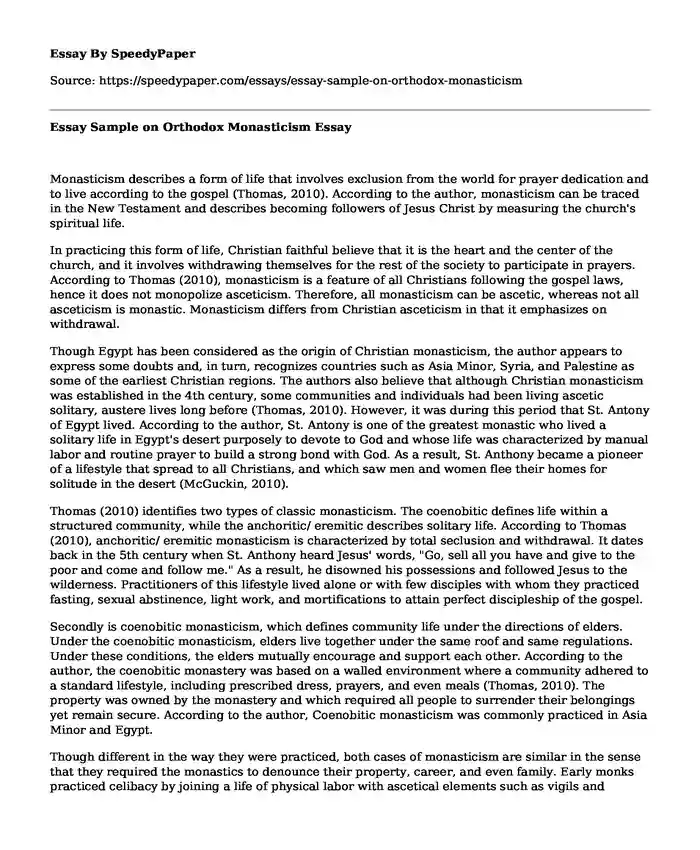
| Type of paper: | Essay |
| Categories: | Christianity |
| Pages: | 3 |
| Wordcount: | 572 words |
Monasticism describes a form of life that involves exclusion from the world for prayer dedication and to live according to the gospel (Thomas, 2010). According to the author, monasticism can be traced in the New Testament and describes becoming followers of Jesus Christ by measuring the church's spiritual life.
In practicing this form of life, Christian faithful believe that it is the heart and the center of the church, and it involves withdrawing themselves for the rest of the society to participate in prayers. According to Thomas (2010), monasticism is a feature of all Christians following the gospel laws, hence it does not monopolize asceticism. Therefore, all monasticism can be ascetic, whereas not all asceticism is monastic. Monasticism differs from Christian asceticism in that it emphasizes on withdrawal.
Though Egypt has been considered as the origin of Christian monasticism, the author appears to express some doubts and, in turn, recognizes countries such as Asia Minor, Syria, and Palestine as some of the earliest Christian regions. The authors also believe that although Christian monasticism was established in the 4th century, some communities and individuals had been living ascetic solitary, austere lives long before (Thomas, 2010). However, it was during this period that St. Antony of Egypt lived. According to the author, St. Antony is one of the greatest monastic who lived a solitary life in Egypt's desert purposely to devote to God and whose life was characterized by manual labor and routine prayer to build a strong bond with God. As a result, St. Anthony became a pioneer of a lifestyle that spread to all Christians, and which saw men and women flee their homes for solitude in the desert (McGuckin, 2010).
Thomas (2010) identifies two types of classic monasticism. The coenobitic defines life within a structured community, while the anchoritic/ eremitic describes solitary life. According to Thomas (2010), anchoritic/ eremitic monasticism is characterized by total seclusion and withdrawal. It dates back in the 5th century when St. Anthony heard Jesus' words, "Go, sell all you have and give to the poor and come and follow me." As a result, he disowned his possessions and followed Jesus to the wilderness. Practitioners of this lifestyle lived alone or with few disciples with whom they practiced fasting, sexual abstinence, light work, and mortifications to attain perfect discipleship of the gospel.
Secondly is coenobitic monasticism, which defines community life under the directions of elders. Under the coenobitic monasticism, elders live together under the same roof and same regulations. Under these conditions, the elders mutually encourage and support each other. According to the author, the coenobitic monastery was based on a walled environment where a community adhered to a standard lifestyle, including prescribed dress, prayers, and even meals (Thomas, 2010). The property was owned by the monastery and which required all people to surrender their belongings yet remain secure. According to the author, Coenobitic monasticism was commonly practiced in Asia Minor and Egypt.
Though different in the way they were practiced, both cases of monasticism are similar in the sense that they required the monastics to denounce their property, career, and even family. Early monks practiced celibacy by joining a life of physical labor with ascetical elements such as vigils and fasting. According to the author, Egyptian monasticism then spread to other regions practicing Christianity through literary testimonies and persona acquaintance.
References
McGuckin, J. A. (Ed.). (2010). St. Antony of Egypt (the Great). John Wiley & Sons.
Thomas, T. (2010). monasticism. John Wiley & Sons. 317-323
Cite this page
Essay Sample on Orthodox Monasticism. (2023, May 01). Retrieved from https://speedypaper.net/essays/essay-sample-on-orthodox-monasticism
Request Removal
If you are the original author of this essay and no longer wish to have it published on the SpeedyPaper website, please click below to request its removal:
- National Telephone & Data Mobile Software Division
- Essay Example: My Personal Integrity
- Free Essay on How the Draft of WW2 Impacted Professional Sports in the US
- Some Questions on the Paper, Have a Heart: Gender Bias in Healthcare
- Personal Experience Essay Example: Chinese in America
- Research Paper on Impact of Historical Events on the Economy of the U.S.
- Free Essay: The NICE Challenge
Popular categories




